AS DISCUSSED LAST YEAR, in our very in-depth companion piece focused on the work of technology and economic historian Carlota Perez, we are soon entering the “Deployment” phase of the current techno-economic paradigm (TEP) or fifth “Great Surge” as she also refers to TEPs in her landmark book “Technological Revolutions and Financial Capital: The Dynamics of Bubbles and Golden Ages.” The fifth great surge since the Industrial Revolution, we refer in common culture to this current period as the Digital Age. In Perez’ analysis and TEP theory model, this fifth era was initiated by the 1971 invention of the Intel microprocessor, a single product that, like the Model T Ford before it, ushered in a new modern era of life.
The Value of Knowing Our Location in History
Since every great surge or TEP has two distinct halves with a turning point phase, we explained last year that we are largely somewhere in the latter years of that turning point. As Perez says, we turn from Installation (of the new paradigm-shifting technologies) to a period of true mass Deployment (of the new technologies). (see image 01 below) What largely seems to be happening this time is the first half, the Installation phase, seems to be unfolding longer than usual through four distinct sub-periods starting with the Intel chip. The four periods are the PC, the Internet, Mobile and now AI (artificial intelligence). We discuss below Google’s presentation at AIA that calls this AI period as the “fourth big shift” in the era of computing. (images 8 – 11) While the Mobile period built itself on the back of the Internet, which itself was built on the back of the PC revolution, this fourth period (or shift) of AI seems to be developing as a major force multiplier of the first three periods and inventions themselves. (see image 10 below) And consequently, Perez’s TEP model for this fifth Great Surge is protracted beyond the typical 20-30 years.
MORE: CAD-CAM Execs Make 2019 Technology Trend Predictions
This challenges Perez’s TEP model which fully involves financial factors into technological revolutions as a single theory model. Are we in fact inside the Deployment phase or not? How does one explain AI, VR, AR technologies within her model? The curious reader is encouraged to read our Perspective from last year or her book itself. Better yet, her talks found on YouTube are a concise intro to her TEP theories. What is important about her theory model is how consist each great surge follows a typical pattern.
There is consistently economic inequality during this phase as financial capital seeks profits in the new technologies while workers in the old technologies suffer de-skilling and depreciated prospects in their vanishing ways of working.
In a nutshell, a great invention is born. It fuels a revolutionary way of living and transforms life for all of society. In its first 20-30 years, the revolutionary new technology goes through an Installation period, displacing the old modality. There is consistently economic inequality during this phase as financial capital seeks profits in the new technologies while workers in the old technologies suffer de-skilling and depreciated prospects in their vanishing ways of working. The consistent turning point phase leads to war or economic depression or both. Society and governments reorganize after these crashes and socially recalibrate society for more equality, meanwhile institutionalizing the new ways of working. The Deployment phase is another 20-30 years of complete diffusion of the new technologies that initiated the revolution, to begin with. (see image 01)
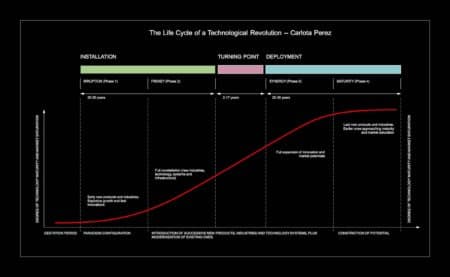
01 – In each great surge (technology-economic paradigm) or TEP society goes through four key phases or periods, plus a 5th turning point phase.
Knowing our place in this TEP theory model is valuable, even if one disregards the economic and social aspects of it (the ebbs and flows of economic equalities). It instructs most powerfully that societies don’t go backward; de-skilling is a fact of life when revolutionary new technologies emerge; entire generations of workers naturally resist the new; the young consistently learn and embrace the new; old ways of doing things always eventually succumb to the new ways of working. If you begin a career while young in the Installation phase, by the time you are retiring you will have ridden the longest wave possible without having great disruption. If you begin your career in the Deployment phase, you will be hit with a new techno-economic paradigm (TEP) shift in your later working years and face “de-skilling.”
This is the larger framework but within this, we look at the entire AEC industry and see a series of related fourth shift innovations in the Digital Era. While AI may be the larger one, we also see VR/AR/MR technologies, drones, 3D printing, and robotics. We collectively refer to these fourth shift group of technologies as emergent technologies or (emTech) as stylized inside our new emTech-focused newsletter INSIDER Xpresso.
In the AEC industry, we seek to understand technology transformation from the 64,000 foot view using large economic history models like that from Carlota Perez, while bringing analysis down to the specific technologies and their localized and trade-specific implications. To use Perez’ term of “diffusion” we acknowledge that BIM, without the underlay of AI, has pushed quite fully into diffusion. But how will VR/AR/MR and AI affect BIM? How will BIM reach full deployment? What institutional factors will bring BIM to full maturity and are we 20 or 30 years away? These questions fascinate us and help us develop frameworks for understanding the smaller movements within technology. And they also help us evaluate a specific technology or company or product against this larger framework.
The Master Builder’s Mind — One Mindedness Among the Many
This year we want to look at our framework in the most distilled way possible. The existential crisis facing humankind is our climate change crisis. But we also face a crisis of division, a crisis of consensus, a crisis of truth. Against this larger backdrop, the AEC industry is still struggling to reset itself in a post-Taylorism world. While flexible production abounds, it has done little to realign the AEC industry to solve its natural hyper-fragmentation and “information silos” problem. We need new technologies that drive at bringing multiple parties together, help multiple stakeholders arrive at consensus around issues and solutions, and insert evidence and science into a set of professions that have long held sway based on simply trust backed up with years of experience.
MORE: Master Builder 2.0—GRAPHISOFT Shapes Its Future Around Integration
As we look ahead we see the need to reimagine the AEC industry through the eyes of the Master Builder period, prior to the Renaissance—prior to the separation of design and construction into two different individuals. (This idea was gained from the GRAPHISOFT KCC 2019 event.) But no one person can do it all, so we must build systems that enhance single minds working in single teams while fostering tools that enable multiple minds and multiple teams to work as one. We need a One Mindedness philosophy of technological transformation—meaning being able to self-examine our beliefs in this industry about the limits and powers of the individual—gaining advantages of the mind of the Master Builder while simultaneously capitalizing on the inputs, values, and geniuses of many minds.
This year we are particularly interested in highlighting the best digital tools that work toward this One Mindedness out of many minds philosophy. Separate tools that enhance the capacity of the many and varied, must learn to speak to each other, so dispersed and unique teams using distinct tools can seamlessly work together in ever-increasing improved flow and real-time.
The 2019 Firm of the year, Payette, a Boston-based firm also reflected these collective values through a broad leadership with professional and community service as part of its DNA in concert with its innovative and recognized architecture. During their award presentation, it was also clear how the younger, diverse voices of the firm contribute to key firm positions integrated deeply into the practice early.
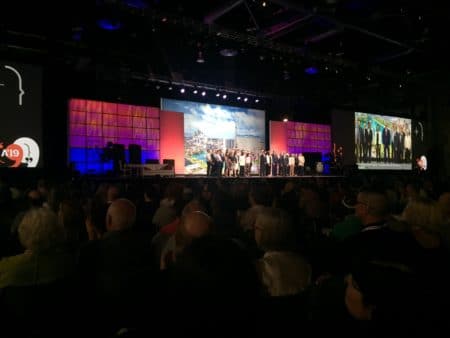
02 – Payette of Boston, 2019 AIA Firm of the Year Award recipient. Payette not only develops bespoke technologies tools but diffuses them freely throughout the industry. Even brand new employees are encouraged to share their views and perspectives through a strong culture of inclusion.
We also saw multiple keynotes that celebrate the importance of getting all minds to be heard, represented and contributing to the great enterprises of life—from empowering girls who code so they can learn bravery and ambition, to the importance of universal access—not simply to enable the physically handicapped to enter and exit buildings but to get those with access needs to contribute to the profession itself by being members of it.
If a new kind of one-mindedness represents the Master Builder’s mind made up of a collection of minds, to build that framework to accommodate and excel with many (if not evermore) minds is an idea worth pursuing. If those with physical disabilities have greater spatial awareness due to those disabilities, why are such folks with great spatial awareness not involved more in the creation of space itself? Why are they not architects? We see that a greater breadth of access brings wider viewpoints and skills to the table. As such, access to tools and technology that are approached from more—not less—device types, platforms, and positions in the world, are of increased value to us all and worth propagating.
Boiling this down to specifics, tools that talk to each other with APIs, more universal file formats, and use more technologies and methods that support the common good, will provide the greater pathway to wider and richer contributions from the diverse and the many.
We saw this theme of one-mindedness in not only in the award winners but also throughout the conference. We will work through two themes which do cross-over but provide some focus across the awards.
Architecture or Gaming?
The first theme, Architecture or Gaming, was quite a phenomena this year. We had seen gaming companies at previous conferences, but not at this year’s level. Both Unreal and Unity had a significant presence on their own, and several additional companies (some previous award winners) continued their strong presence. The clear picture was that this seemed to be the year that gaming technologies and AEC software really came together. That was obvious with the innovation awards and even BIM awards this year. Unity Reflect showed a serious tie into the industry through Autodesk and Revit, and Epic showed its hand with its recent acquisition of TwinMotion that was also being shown in ARCHICAD 23 and released this fall. Vectorworks also had a strong lead into this convergent space with its partnership with Lumion. These solutions exhibited federated live-linking with multiple (BIM) software stakeholders (with the data) and the capability to export to almost any device for interaction with the design in a game-like environment. This capability really adds to the collaborative democratization of AEC data for all stakeholders on many platforms anywhere, anytime. This is a significant advance for the industry and profession. The Common Data Environment (CDE) is getting that much closer when the prominent game engines are the platform that connects…

03 – A Revit model is inside Unity Reflect, another democratizing technology that will bring BIM to more participants in the design-build-operate domains.
Another part of this anytime anywhere experience is also continuing to engage the extended reality (XR) industry which encompasses, virtual reality (VR), (AR) and even mixed reality (MR). Many of the companies previously reported on were present, but the biggest splash at A’19 was the arrival of Magic Leap One. The booth had reservations the entire conference. It was quite impressive and worthy of award this year and only framed the importance of these tools for the AEC profession and industry. Another XR platform, Station IX, also a new exhibitor at A’19 was also demonstrated with a high very demand throughout the conference. Reflected Reality (their appropriate description) really changed the immersive experience at a very high fidelity (near retinal resolution). The viewing surface is a mirror, which from the center of the display made for a very rich, convincing and exciting experience. With the resurgence of VR recently with lower cost headsets, it’s promising for AEC to be able to leverage this super high-quality immersive display, a newer technical immersive solution, for communicating high-quality design.
Additional examples in this crossover gaming and media space were shown at A’19. The new Oculus Quest and Rift S were both shown. Exciting hardware built by Reification was demoed on the exhibit floor shifting from VR to MR experiences on the fly. Even the award winner VIM AEC was connected to this XR theme directly being partnered with Magic Leap as an exclusive partner and media device for their CDE platform.
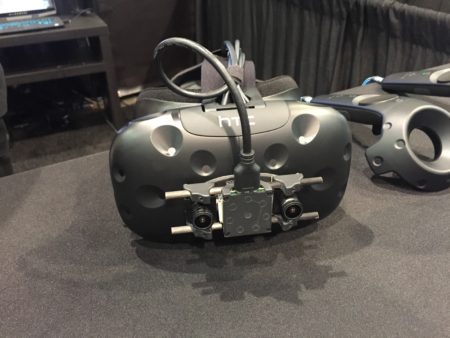
04 – Reification’s HTC Vive headset is a hacked MR device from a company offering a compelling mixture of VR and MR. Gaming technology is democratizing technology as this technology will eventually fully diffuse.
The ability for AEC to transport users between design ideation and user experience in an extended reality is clearly effective and important. New technologies to watch continuing to push XR over the next year will be these award winners and others not yet (visibly) on the conference scene such as OTOY/Octane Render 3 and Varjo. How we exist in these digital twins, these extended realities, provide thick conduits for effective understanding of how a design works and functions, and in the all too familiar perception of reality. What looks to be exciting with the gaming convergence, in its easy plug-and-go iterative live-linking (potential CDE), is that the information and deeper data will be accessible in new ways to see and make “design” even better in this complex world of today for all involved.
Bespoke Apps, APIs, and Big Data
The second theme pulling the awards together at A’19 was data. There were discussions of big data and open data and even data exchange, extending ideas of an open BIM at a deeper and finer granularity. This is important as the profession attempts to identify itself in the 21st Century. Clearly, things have changed, and the complexity of the built environment is a multitude more complicated than days prior. Again, thinking about the Master Builder with 21st Century tools, but this year’s conference made it clear that in almost every case and as Robert Ivy, FAIA described, a “collective genius” will win the day with the best solutions. Evermore, data and technology and presciently called in Session SA 220 “Designing in an Age of Technology, Data Visualization & AI” the “computational collective.”
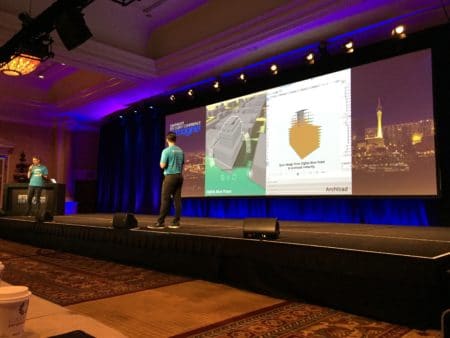
05 – Graphisoft offers a glimpse of the granularity of data and BIM and new modes of connectivity and inter-app design and performance.
And speaking of computation, GRAPHISOFT’s ARCHICAD 23 continues its deep integration with McNeel’s Grasshopper, opening up the BIM application to the full spectrum of Rhino + Grasshopper ecosystem of applications such as Ladybug. The company also has future technologies (not shown at AIA but shown at their KCC in Vegas just days before AIA) that accelerates data exchange in AEC through a deeper more extended definition of BIM. (see: Architosh, “Master Builder 2.0—GRAPHISOFT Shapes ITs Future Around Integration,” 20 Jun3 2019). The company’s upcoming BIMx features a next-gen streaming engine and its own API bringing the power of BIMx to the web browser. This will undoubtedly have ripple effects for the company as BIMx is unrivaled in its user-experience (UX) between drawings, models and BIM data.
VIM AEC also exhibited an approach to data exchange where the data throughout the experience is highly streamlined through game engine technology. VIMaec’s relationships with Unity and Magic Leap puts data and data visualization central in the CDE that covers the design to construction to facilities management.
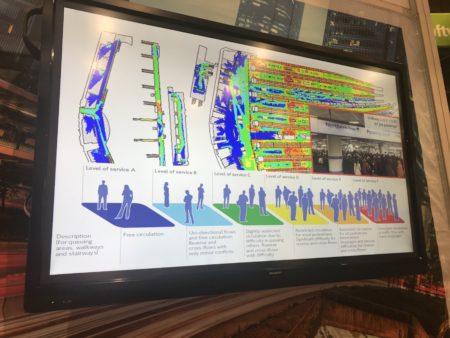
07 – Bentley’s LEGION pedestrian simulation technology shown in action here on this screen helps architects design safer, more efficient and effective transit buildings. From the Bentley booth at AIA 19.
And Bentley’s Open Buildings Station Designer leverages a heavy-weight simulation solution (Legion) for a specific building typology design tool. While still BIM, this data-rich simulation environment (a dynamic digital twin) aims to improve user experience and infrastructure effectiveness in meaningful ways. It was a bespoke approach to creating a design solution, or a design application for a specific purpose that is really intriguing–even the heavy-weight establishment is moving rapidly toward bespoke and open technology solutions.
Layer App, born from an Architecture firm in the middle of the US, has deep development into project workflow communications and integrations into BIM (Revit currently). Designed to catch project communication errors early, it excels with an advanced interface and modern web tools such as hashtags and JSON APIs. This approach is aimed at both complex projects and small offices–a tool more open, flexible and accessible. Thematically spot on for this year’s conference.
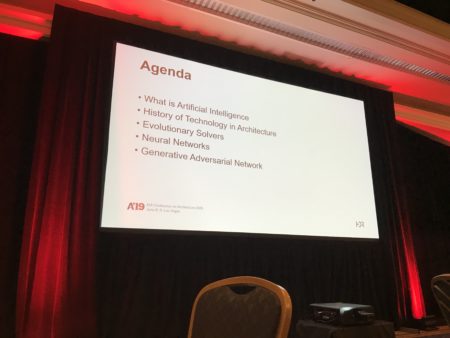
08 – AI, history of technology in architecture, evolutionary solvers, neural networks and generative adversarial networks.
In multiple conference sessions, the advances in machine learning, robotics, solvers artificial intelligence and even generative adversarial networks reinforced the data to design theme. Firms are taking the initiative by supporting in-house R&D groups. HDR, Ennead Architects, Payette, Buro Happold, and others exhibited progressive transdisciplinary forays into technology and its relationship to the built environment. Buro Happold has created an open, mass-participation tool development space ( http://bhom.xyz ) to share applicable building design code. They are specifically targeting difficult challenges with these co-created tools as measuring behavioral and qualitative input and output.
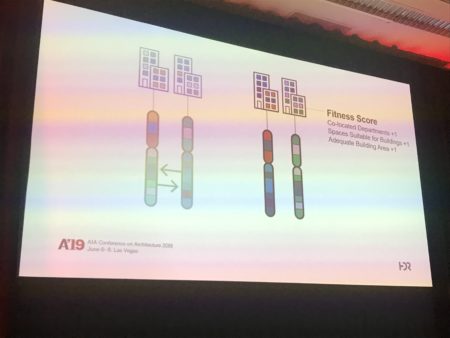
09 – Fitness scores and the use of AI to transform the application of architectural design methodology.
Google also presented a session on their AEC vision in the frame of the 4th shift in computing technology (PC, Web, Mobile, and now AI) and circled around 4 factors they see revolving around how people live in the built environment: (1) voice as the new input, (2) cutting the cord, (3) on-demand services, and (4) smart home technology and how people build in the built environment: (1) drones & package delivery, (2) autonomous vehicles, modular building, and (4) Smart buildings. These are major shifts in how the population will exist and Google incubator (X) companies seem to be at the inflection point of data and AEC with major changes forecast.

10 – The fourth big shift in the era of computing. PC, Web, Mobile and now AI. Unlike past TEPs (techno-economic paradigms) the current 5th great surge has come in a series of linked waves that build on top of each other like Lego blocks. AI appears to be like the Lego board that grounds the three prior blocks and provides connectivity and linkages among all the previous three.
One other related keynote to touch on was Zipline ( https://flyzipline.com ). As if to bring home the Google message about drones and delivery, Zipline showed how they had developed an entire ecosystem around phone based technologies and a drone they developed to bring emergency medicines and blood throughout Rwanda and Ghana, Africa. Their system, so successful, is becoming a model for the US and FAA to test such services in the United States—potentially this year. The message of their work was already powerful, but then considering how open, collaborative and innovative they were to create this technology system and how it is now a model for others to develop around (right now) only emphasized how quickly these “developmental bumps” will be moving technology solutions forward and how it will impact the work that the AEC industry will do.
All told, meaningful and measurable work around developing data and technology is happening right now, which the Architosh 2019 Best of Show award winners clearly exhibited at an exciting and innovative level in Las Vegas at A’19.
Conclusion
In the “Learning from Las Vegas,” site and theme of AIA 2019, the lessons were people voting with their feet. Today, innovative firms and organizations are seeing deeper, focusing on things that matter, moving the status quo through dedicated R&D groups, incorporating diverse voices and younger voices for forward progress and fighting the status quo. The continued changes and innovations we saw this year at A’19, the development bump, recognizes a wider and broader approach to solving architectural and design problems with integrated technologies and processes.
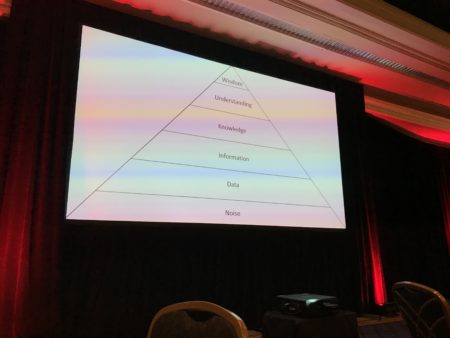
11 – From Noise to Wisdom one must gather Data, organize into Information, transform into Knowledge, build Understanding and accrue Wisdom through its application.
Solving these complex challenges at a community level (and higher), for resilience, for cultural nuances, for universal access, even with robots as users, requires all the computational collective genius possible, to elevate the use of data and information to synthesized higher level solutions.
(editor’s note: Anthony Frausto-Robledo, AIA, LEED AP, also contributed this article.)

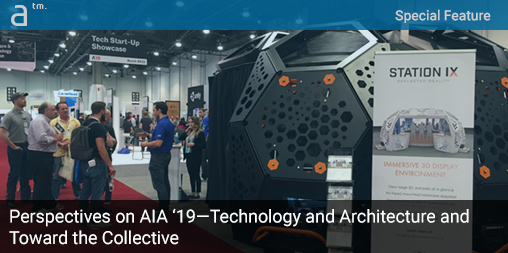


Reader Comments
Excellent article in many respects. The author addresses some of the unspoken, thus confusing to some, forces currently in place.
I challenge the author and industry as a whole to always look at the industry as AECO(M)O. Those who continue to view this as an AEC industry do so at their own peril.
The digital currency of the 21st century is content. The same content that is used in the 10% financial segment known as AEC lives through the full building lifecycle. In terms of time in the full building lifecycle, AEC comprises somewhere between 20% (retail, B2C) and 1% (Institutional).
Excellent article in many respects. The author addresses some of the unspoken, thus confusing to some, forces currently in place.
I challenge the author and industry as a whole to always look at the industry as AECO(M)O. Those who continue to view this as an AEC industry do so at their own peril.
The digital currency of the 21st century is content. The same content that is used in the 10% financial segment known as AEC lives through the full building lifecycle. In terms of time in the full building lifecycle, AEC comprises somewhere between 20% (retail, B2C) and 1% (Institutional).
Steve Holzer, thanks for your compliments on the article. I am sure Pete will appreciate the kind words and your observations are spot on. We agree with your terminology issue and we need to do better in that area.
Steve Holzer, thanks for your compliments on the article. I am sure Pete will appreciate the kind words and your observations are spot on. We agree with your terminology issue and we need to do better in that area.
Comments are closed.